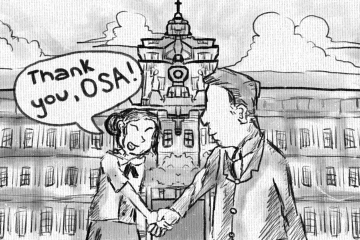 “Bakla ba ‘yun? Paano ba siya gumalaw?” my high school friend asked as he talks about our Christian Living Education teacher. I could not help but squint my eyes at him for a moment, initially showing judgement. I, however, began to ask myself who or what exposed him to this kind of perception: sexual orientation being synonymous to gender expression; how the effeminate movements of a man can reflect his attraction to the same gender. After careful reflection and research, what avenue would largely impose such stigma to society than the mass media?
“Bakla ba ‘yun? Paano ba siya gumalaw?” my high school friend asked as he talks about our Christian Living Education teacher. I could not help but squint my eyes at him for a moment, initially showing judgement. I, however, began to ask myself who or what exposed him to this kind of perception: sexual orientation being synonymous to gender expression; how the effeminate movements of a man can reflect his attraction to the same gender. After careful reflection and research, what avenue would largely impose such stigma to society than the mass media?
Developmental psychologists Jerel P. Calzo and Monique Ward state how regular consumption of media like the television and Internet leads its users to develop beliefs about certain ideas—among which is homosexuality—that coexist with what media projects. Iman Tagudina from the Ateneo de Manila University added how such can be problematic when the media projects a lesbian, gay, bisexual, and transgender (LGBT) representation that is one-dimensional, a portrayal that remains repetitive until its demise. This becomes a path to perpetuate stereotypes such as silly, unstable in the realm of love, and immoral. Tagudina cites how Sheng Kuan Chung, a professor of Art Education, sees the way members of today’s generation perceive social reality through television and cinema screens that may give false assumptions and prejudices on members of the LGBT community. In short, the media has this superpower, deceiving society with false perceptions about people.
One recent example of this deception is the hit song Titibo-Tibo interpreted by Moira Dela Torre. Lesbian, in Filipino translation, is tomboy or tibo. However, Dela Torre and songwriter Libertine Amistoso made it seem as if it was a phase, a mere expression, and women’s abandonment of their sexual orientation or gender identity to suit society’s heteronormative standards.
In her column for CNN, Samantha Lee, director of the LGBT film Baka Bukas, targeted the song’s lyrics in which the seemingly lesbian woman gives up her self-expression when she met a boy. This representation from a powerful form of media like music leads people to false perceptions. The media should use its capacity to withdraw these kinds of stereotypes and state that the only stereotype a person should have is having limitless possibilities.
Literary writer J. Neil Garcia, in his work titled Male Homosexuality in the Philippines: A Short History, believed that the Filipino society would be more tolerant of homosexuality if Filipino television would not only frequently show flamboyant homosexuals in drag screaming their lungs out, but two typical males showing signs of affection, as well. This, I believe, would allow the public to see how homosexuality is not just about the stereotypical “effeminate, cross-dressing men” as Garcia described, but as people who simply love who they want to love.
With the recent approval of the Anti-Discrimination Bill in Congress, the possibility of imposing stereotypes on LGBTs will come to a minimum. The bill states that promotion of stigma for sexual orientation and gender identity or expression in media, educational text books, and other forms of medium is prohibited. Sen. Risa Hontiveros previously said the bill will guarantee that stigmas on LGBTs will not prohibit them for opportunities on education, health care, employment, and other basic rights.
Support for the Anti-Discrimination Bill and its proximity to becoming a law promises equality and equity for our LGBT brothers and sisters. Help our fellow human beings in this quest for fairness through your own small ways. Reject the imposed stigma inflicted upon them by the media. Make everyone feel safe in their own uniqueness. Embrace diversity! F
For feedback, email adamlaurena.theflame@gmail.com.



